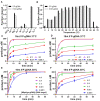A programmable pAgo nuclease with RNA target preference from the psychrotolerant bacterium Mucilaginibacter paludis
- PMID: 35524569
- PMCID: PMC9122594
- DOI: 10.1093/nar/gkac315
A programmable pAgo nuclease with RNA target preference from the psychrotolerant bacterium Mucilaginibacter paludis
Abstract
Argonaute (Ago) proteins are programmable nucleases found in eukaryotes and prokaryotes. Prokaryotic Agos (pAgos) share a high degree of structural homology with eukaryotic Agos (eAgos), and eAgos originate from pAgos. Although eAgos exclusively cleave RNA targets, most characterized pAgos cleave DNA targets. This study characterized a novel pAgo, MbpAgo, from the psychrotolerant bacterium Mucilaginibacter paludis which prefers to cleave RNA targets rather than DNA targets. Compared to previously studied Agos, MbpAgo can utilize both 5'phosphorylated(5'P) and 5'hydroxylated(5'OH) DNA guides (gDNAs) to efficiently cleave RNA targets at the canonical cleavage site if the guide is between 15 and 17 nt long. Furthermore, MbpAgo is active at a wide range of temperatures (4-65°C) and displays no obvious preference for the 5'-nucleotide of a guide. Single-nucleotide and most dinucleotide mismatches have no or little effects on cleavage efficiency, except for dinucleotide mismatches at positions 11-13 that dramatically reduce target cleavage. MbpAgo can efficiently cleave highly structured RNA targets using both 5'P and 5'OH gDNAs in the presence of Mg2+ or Mn2+. The biochemical characterization of MbpAgo paves the way for its use in RNA manipulations such as nucleic acid detection and clearance of RNA viruses.
© The Author(s) 2022. Published by Oxford University Press on behalf of Nucleic Acids Research.
Figures







Similar articles
-
A programmable pAgo nuclease with RNA target-cleavage specificity from the mesophilic bacterium Verrucomicrobia.Acta Biochim Biophys Sin (Shanghai). 2023 Jul 10;55(8):1204-1212. doi: 10.3724/abbs.2023110. Acta Biochim Biophys Sin (Shanghai). 2023. PMID: 37431184 Free PMC article.
-
A mesophilic Argonaute from Clostridium formicaceticum with efficient DNA cleavage activity guided by small DNA.Structure. 2025 Jun 5;33(6):1101-1111.e3. doi: 10.1016/j.str.2025.03.002. Epub 2025 Mar 28. Structure. 2025. PMID: 40157363
-
A bacterial Argonaute from Tepiditoga spiralis with the ability of RNA guided plasmid cleavage.Biochem Biophys Res Commun. 2023 Jan 15;640:157-163. doi: 10.1016/j.bbrc.2022.11.097. Epub 2022 Dec 1. Biochem Biophys Res Commun. 2023. PMID: 36512847
-
A long look at short prokaryotic Argonautes.Trends Cell Biol. 2023 Jul;33(7):605-618. doi: 10.1016/j.tcb.2022.10.005. Epub 2022 Nov 22. Trends Cell Biol. 2023. PMID: 36428175 Review.
-
Argonaute proteins confer immunity in all domains of life.Curr Opin Microbiol. 2023 Aug;74:102313. doi: 10.1016/j.mib.2023.102313. Epub 2023 Apr 4. Curr Opin Microbiol. 2023. PMID: 37023508 Review.
Cited by
-
Characterization of Argonaute Nuclease from Mesophilic Bacterium Chroococcidiopsis.Int J Mol Sci. 2025 Jan 27;26(3):1085. doi: 10.3390/ijms26031085. Int J Mol Sci. 2025. PMID: 39940853 Free PMC article.
-
Short prokaryotic Argonaute systems trigger cell death upon detection of invading DNA.Cell. 2022 Apr 28;185(9):1471-1486.e19. doi: 10.1016/j.cell.2022.03.012. Epub 2022 Apr 4. Cell. 2022. PMID: 35381200 Free PMC article.
-
Bacterial Argonaute Proteins Aid Cell Division in the Presence of Topoisomerase Inhibitors in Escherichia coli.Microbiol Spectr. 2023 Jun 15;11(3):e0414622. doi: 10.1128/spectrum.04146-22. Epub 2023 Apr 27. Microbiol Spectr. 2023. PMID: 37102866 Free PMC article.
-
In vitro characterization of a pAgo nuclease TtdAgo from Thermococcus thioreducens and evaluation of its effect in vivo.Front Bioeng Biotechnol. 2023 Mar 2;11:1142637. doi: 10.3389/fbioe.2023.1142637. eCollection 2023. Front Bioeng Biotechnol. 2023. PMID: 36937752 Free PMC article.
-
Structural and mechanistic insights into a mesophilic prokaryotic Argonaute.Nucleic Acids Res. 2024 Oct 28;52(19):11895-11910. doi: 10.1093/nar/gkae820. Nucleic Acids Res. 2024. PMID: 39315697 Free PMC article.
References
-
- Swarts D.C., Jore M.M., Westra E.R., Zhu Y., Janssen J.H., Snijders A.P., Wang Y., Patel D.J., Berenguer J., Brouns S.J.J.J.et al. .. DNA-guided DNA interference by a prokaryotic Argonaute. Nature. 2014; 507:258–261. - PMC - PubMed
MeSH terms
Substances
Supplementary concepts
LinkOut - more resources
Full Text Sources
Research Materials

